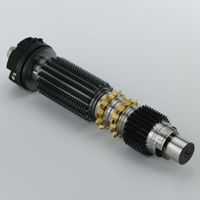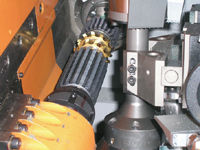Finish Hobbing Crowned Helical Gears without Twist
 A machine operator mounts a gear blank in a hobber. A few moments later, he removes the workpiece, a crowned helical gear that has been finished, deburred and chamfered--and that has no twist.
A machine operator mounts a gear blank in a hobber. A few moments later, he removes the workpiece, a crowned helical gear that has been finished, deburred and chamfered--and that has no twist.
This combination of operations is possible using a new product available from LMT-Fette Inc. The product is a tool system that consists of a roughing hob, a set of deburring and chamfering tools, and a finishing hob, all mounted on one arbor. The finishing hob is the tool that removes twist from gears. Called a "twist-free hob," the tool was designed for high-volume production of the same or similar gears. Jointly developed by the Liebherr Group and Fette, the tool can be made to hob external spur or helical gears without twist, also called profile bias.
Twist is a defect that can result in more gear noise and less load carrying capacity. The defect is caused by large tapers or crowning, especially on helical gears. Twist occurs on both spur and helical gears, but it’s negligible on spurs.
In the past, twist was corrected via finishing operations. "This correction has been done in grinding for a while," says Reinhold Cordella, a regional sales manager for Liebherr Gear Technology Inc. in Saline, MI. Other finishing methods for removing twist included shaving and honing.
The twist-free hob, however, eliminates the defect via its modified profile and its diagonal movement across gear teeth. The hob’s modification is a gradient change in its profile. This change is synchronized with diagonal hobbing so the tool can both finish hob and compensate for twist in the same operation.
In principle, the twist-free hob can be used on any hobber capable of diagonal hobbing, says Oliver Winkel, application engineer-gear cutting for Liebherr Verzahntechnik GmbH of Kempten, Germany.





 During operation, the hob head swivels to different angles to rough hob,to deburr and chamfer and to finish hob, so the lead and helix angles are correct for the two hobs and the lead angle is also correct for the deburr-chamfer tools.
During operation, the hob head swivels to different angles to rough hob,to deburr and chamfer and to finish hob, so the lead and helix angles are correct for the two hobs and the lead angle is also correct for the deburr-chamfer tools.